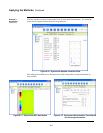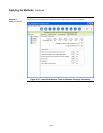
7-2
This list provides brief descriptions of various terms relating to this publication:
ABSORPTION COEFFICIENT – The ratio of absorbed-to-reflected sound. The absorption
coefficient has a range of 0 to 1.
“A” WEIGHTED DECIBEL – The ear is less sensitive to low frequency pitch at low volume
levels, the “A” weighted correction curve is applied to SPL measurements to equalize the loudness
of sounds over the hearing range. Meters configured with the “A” weighted filter read out in units
of dBA, short for “A” Weighted Decibel.
AHJ – The “Authority Having Jurisdiction” is the organization or person responsible for
approving fire alarm installations for occupancy.
AUDIBILITY – A measure of loudness of a sound. When used with respect to fire alarm
systems, audibility is regarded as the evacuation signal level above background noise.
CIS – The “Common Intelligibility Scale” is a standardized scale that correlates a variety of
intelligibility measurement methods.
CLIPPING – When part of the electrical signal path exceeds the capacity of the component audio
“Clipping” can occur, causing a reduction in intelligibility.
COMBINATION SYSTEM – A fire alarm system that is also used for non-fire alarm functions.
Combination Systems contain not only typical configurations of fire alarm and emergency
voice/alarm communications systems, but also sound systems for background music and paging
for non-emergency messaging.
COMMAND CENTER – The area of a building (usually near the entrance) that acts as the
communications center for emergency personnel. The command center is used to display the fire
alarm system status and control the annunciation system. This area typically includes the
equipment required to generate and distribute messages throughout the building’s fire alarm audio
network.
CONSTANT VOLTAGE – Speakers used for a distributed emergency evacuation system are
wired as a “Constant Voltage” system, where the voltage at each speaker is the same (typically
25V or 70.7V) at the maximum power output of the amplifier.
COVERAGE ANGLE – The angle where the speaker Sound Pressure Level (SPL) drops 6 dB
from the on-axis SPL.
COVERAGE AREA – The plane where the Sound Pressure Level (SPL) at the edge of the plane
drops 6 dB below the on-axis SPL.
CRITICAL POLAR ANGLE – The angle where the sum of the distance loss and the polar loss
is 6 dB less than the on-axis Sound Pressure Level (SPL).
DECIBEL – A unit used to express relative difference in power, usually between acoustic or
electric signals, equal to ten times the common logarithm of the ratio of two power levels or
20 times the common logarithm of the ratio of two voltage levels.
DIGITAL RISER – A digital system that transmits multiple channels of digital audio throughout
a facility. A single pair of wire is used to transmit up to eight channels of digitally encoded audio
signals. The digital riser is considered a signaling line circuit, and is wired in a Style 4 or Style 7
configuration.
DIRECTIVITY FACTOR “Q” – A common representation of speaker directivity for speakers
having a conical coverage pattern (typical of single driver speakers used in fire alarm
applications). Q is determined by an equation covered in Chapter 2 of this manual.
Continued on next page
Glossary
Glossary or Terms


















